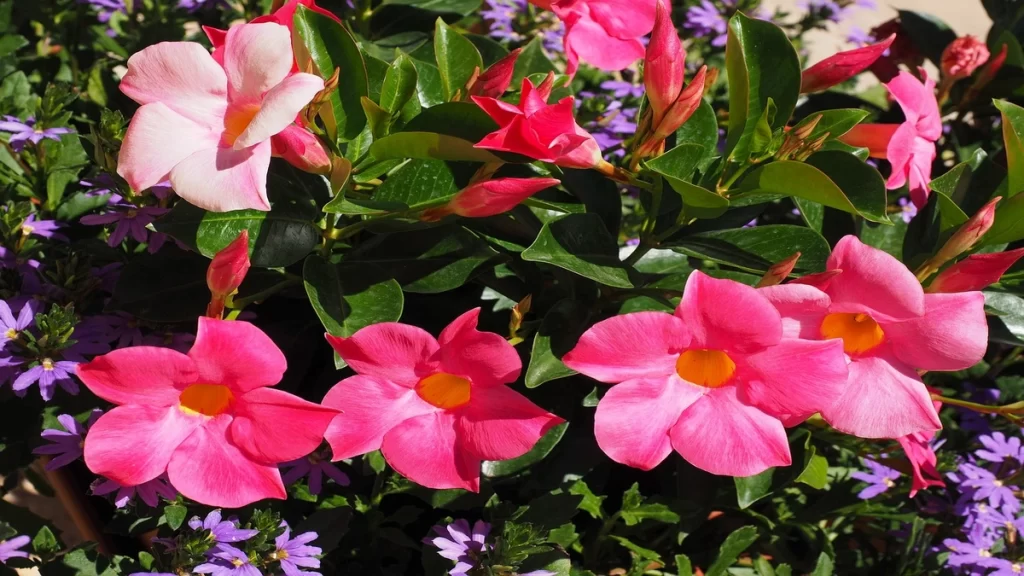Discover Mandevilla, a tropical vine and a vivid, trumpet-shaped flowered species. A splash of color and underground connection to the tropics, this plant is ideal for use as a trellis or container plant or for adorning walls. Find out how to take care of and keep Mandevilla happy so it can flourish and improve your outdoor spaces with pretty blooms.
Introduction to Mandevilla
If you are looking for something climbing that will add vertical interest to your garden, then Mandevilla is a wonderful tropical vine with spectacular trumpet-shaped flowers. It is so robust a climber that it is a ‘must have.’ Mandevilla is native to Central and South America and is suited for a variety of outdoor spaces, giving them a feeling of tropical flair. Its colors run deep reds, vibrant pinks, and pure white and provide the versatility for garden design or drama in landscape arrangements with a dramatic and focal point.

Optimal Growing Conditions
The ideal conditions for Mandevilla to grow successfully are unique since it is a tropical plant. Because it grows well in USDA hardiness zones 9-11, where temperatures can be consistently above 50 degrees Fahrenheit, it thrives. The mandevilla plants need full sunlight at least some of the day to maximize foliage health and flower production. This vigorous growing plant requires good, healthy, draining soil rich in organic matter without waterlogged roots that can lead to disease.
Planting and Support
To get a Mandevilla to become successful, it needs to be placed in the correct location. If you’re going to be putting it in a garden bed, make sure it is near a structure such as a trellis, arbor or fence in which it can climb to ‘show off its beauty’. If you’re growing Mandevilla in containers, be sure to choose a large container in which the Mandevilla fits easily and has considerable drainage holes. Flexibility is the name of the game when it comes to containers and this tropical beauty can be moved to optimal locations around the growing season and offered up to limited space gardeners as a wonderful opportunity.
Watering Requirements
These vines need active care and consistent moisture to maintain a lush, vibrant appearance. During hot weather, water the plant deep when the top inch of soil dries out, usually once every few days. Although Mandevilla does not like soggy conditions, it’s important not to over-water. Giving soil a chance to dry a little bit between waterings and keeping flowers and foliage a regular humidity for balance of hydration without rotting the roots will improve root growth and battling root rot.

Fertilization Strategy
Mandevilla does best if fertilized regularly to support its prolific growth. During the spring and summer months, use a balanced, water soluble feed for flowering plants every two weeks. So that the plant continues to grow vigorously and flower continuously. Also be careful not to over fertilize, as this will encourage large amounts of foliage growth at the compromise of flowers.
Pruning and Maintenance
In fact it’s essential to shape the vine as well as encourage thicker growth and more flowers. Prune Mandevilla frequently during its active growing season to remove dead or yellowed leaves and to control size and shape. It will also help to improve air circulation around the plant as this prevents fungal disease. In areas that are cooler, you can overwinter by pruning more and thus help bring the plant into balance again at the end of the growing season, if you live in a cooler climate or if you are a grower that likes to shorten vine length.
Learn More: How Much Water Should I Drink Each Day? The Ultimate Guide to Hydration
Overwintering Mandevilla
Mandevilla needs to be overwintered indoors in regions where temperatures fall below 50 degrees Fahrenheit. Once the plant has finished flowering, prune it back by about one-third and check for pests before the first frost. Plants the Mandevilla in a cool, sunny spot. Allowing the plant to rest during the winter months will help reduce watering and prevent root rot in cooler conditions.
Common Pests and Disease Management
Mandevilla is reasonably hardy but can suffer from certain pests, such as spider mites, aphids, and mealy bugs, which can be a particular problem when the plant is grown indoors or in a dry environment. Prevention is the best way to keep off infestations: regular inspections and washing the leaves with a gentle water spray. If pests fail to disappear, use an insecticidal soap or neem oil to knock these insects out of the garden without damaging the plant.
Mandevilla Care Essentials and Varieties
The mandevilla plant can bloom classic pink, striking red, and delicate white mandevilla, which are largely loved for their lush and vibrant blooms. The mandevilla vine climbs well and is versatile for planting in pots, gardens, and other garden settings. Taking care of mandevilla is not difficult but it requires keeping it well watered and providing the right balance of fertilizer to support its quick growth and abundant flowering. Mandevilla plant care in winter is absolutely vital and particularly if you’re living in a cooler climate, as it’s a tropical plant that doesn’t tolerate freezing temperatures. Tender perennials are worth overwintering indoors or in a greenhouse to live year after year once they start growing.
Key Points to Remember:
- Sunlight and Temperature: Mandevilla can grow in the hottest, most sun that you can provide.
- Water and Soil: Offer consistent moisture, avoiding root diseases while providing well-draining soil.
- Support Structures: Mandevilla is a vine and needs to climb, so use trellises or other supports.
- Fertilization: Feeding during the growing season – and at other times if there is a growing season! – is a regular thing that helps make flowers.
- Winter Care: Overwinter in a cooler climate to protect from cold.
- Pest Management: Keep on monitoring and treating for pests in order to keep the plant healthy.
If you follow these suggestions, your Mandevilla will be healthy and provide a fantastic tropical accent to your garden every year. Mandevilla vigorously grows and displays stunning flowers, so you’ll be amazed at just how much work this plant is going to do for you, whether you put a trellis out or a container or use it as a swath across your garden wall.
FAQs
Where does the Mandevilla Plant grow and what is it?
Mandevilla plant is a tropical vine with spectacular trumpet shaped flowers in bright colours,usually pink, apricot and white. This tropical plant does best in warm climates USDA hardiness zones 9 to 11. Mandevillas grow as pretty flowering vines in a tropical garden on trellises, fences, or hanging baskets. To grow, they need full sun for at least 6 hours a day and well draining soil.
How to care for my mandevilla plant?
Mandevilla care means giving them suitable conditions such as good sunlight, adequate water, and nutrients. Ensure that you plant your mandevilla plant in a place that receives full sun and preferably six hours of direct sun each day. Water your plant regularly, keeping the top inch of the soil dry, everything in between. In the spring and summer, apply every two weeks a general purpose fertilizer to stimulate healthy growth and abundance of blooms.
Can I have mandevilla indoors?
Yes, you can grow mandevilla as a houseplant, but that’s only if you have the conditions right. Put your mandevilla plant near an open window where there is plenty of sun. It supports a minimum of four to six hours of direct sunlight each day. The outdoor environment needs to be moist enough, whereas mandevillas like a humid indoor environment. Sometimes, you will need to regularly mist the foliage or place a humidifier in the general vicinity so as to maintain those optimal P.P.H. levels.
What type of soil is best for mandevilla?
Mandevilla best planted in a well draining potting mix. Pick a potting mix made up of organic matter, like peat moss or compost, to keep the moisture in without letting it run off.. Grow on compost-amended garden bed soil if you are planting in a garden bed; otherwise, amend the soil you’re planting in with compost to increase drainage and nutrient content. Don’t plant in heavy clay soils, as they can cause root rot.


